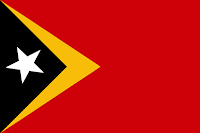The Democratic Republic of Timor-Leste (
tiˈmɔr ˈlɛʃteɪ), commonly known as East Timor(Tetum: Timór Lorosa'e, Portuguese: Timor-Leste), is a sovereign state in Southeast Asia.It comprises the eastern half of the island of Timor, the nearby islands of Atauro and Jaco, and Oecusse, an exclave on the northwestern side of the island, within Indonesian West Timor. The small country of 15,410 km²
(5,400 sq mi) is located about 640 km (400 mi) northwest of Darwin, Australia.
East Timor was colonized by Portugal in the 16th century, and was known as Portuguese Timor
until Portugal's decolonization of the country. In late 1975, East
Timor declared its independence, but later that year was invaded and occupied by Indonesia and was declared Indonesia's 27th province the following year. In 1999, following the United Nations-sponsored act of self-determination, Indonesia relinquished control of the territory and East Timor became the first new sovereign state of the 21st century on May 20, 2002. East Timor is one of only two predominantly Roman Catholic countries in Asia, the other being the Philippines.
East Timor has a lower-middle-income economy
.It continues to suffer the aftereffects of a decades-long independence struggle against Indonesia, which damaged infrastructure and displaced thousands of civilians. It is placed 120th by Human Development Index (HDI).
"Timor" derives from
timur, the word for "east" in Indonesian and Malay, which became
Timor in Portuguese and entered English as
Portuguese Timor.
Lorosa'e (
lit "rising sun") is the word for "east" in Tetum.
The official names under the Constitution are
República Democrática de Timor-Leste in Portuguese and
Repúblika Demokrátika Timor-Leste in Tetum. The Indonesian name
Timor Timur, abbreviated
Timtim, is now less widely used, with the Indonesian government and media now using
Timor Leste.
The International Organization for Standardization (ISO) official short form in English and all other languages is
Timor-Leste (codes: TLS & TL), which has been adopted by the United Nations,
the European Union,
and the national standards organisations of France (AFNOR), the United States of America (ANSI),
United Kingdom (BSI), Germany (DIN) and Sweden (SIS). A notable exception to this practice is Australia, which uses "East Timor".
The island's former two-letter country code, TP, is gradually being phased out.
East Timor's two official languages are Portuguese and Tetum, which belongs to the Austronesian family of languages spoken throughout Southeast Asia.
The predominant form of Tetum, known as
Tetun-Dili, grew out of the dialect favored by the colonizers at Dili, and thus has considerable Portuguese influence, but other dialects of Tetum are also widely used in the country, including
Tetun-Terik which is spoken along the southwestern coast. Indonesian
and English are defined as working languages under the Constitution in
the Final and Transitional Provisions, without setting a final date.
Another fifteen indigenous languages are spoken: Bekais, Bunak, Dawan, Fataluku, Galoli, Habun, Idalaka, Kawaimina, Kemak, Lovaia, Makalero, Makasai, Mambai, Tokodede, and Wetarese.
Under Indonesian rule, the use of Portuguese was banned, but it was
used by the clandestine resistance, especially in communicating with the
outside world.
The language, along with Tetum, gained importance as a symbol of
resistance and freedom and was adopted as one of the two official
languages for this reason, and as a link to nations in other parts of
the world. It is now being taught and promoted widely with the help of Brazil, Portugal, and the Latin Union,
although its prominence in official and public spheres has been met
with some hostility from younger Indonesian-educated Timorese.
According to the 2006 UN Development Report (using data from official census), under 5%of the Timorese population is proficient in Portuguese. However, the
validity of this report has been questioned by members of the Timorese
National Institute of Linguistics,
which maintains that Portuguese is spoken by up to 25% of Timorese,
with the number of speakers more than doubling in the last five years.
Along with other local languages, Tetum remains the most common means
of communication between ordinary Timorese, while Indonesian is still
widely used in the media and school from high school to university. A
large proportion of words in Tetum are derived from Portuguese, but it
also shares many Malay-derived words with Indonesian. Many Indonesian
words are still in common use in Tetum and other Timorese languages,
particularly numbers.
East Timor is a member of the Community of Portuguese Language Countries (CPLP), also known as the Lusophone Commonwealth, and a member of the Latin Union. It is the only independent state in Asia with Portuguese as an official language, although this is also one of the official languages of China's Special Administrative Region of Macau.



